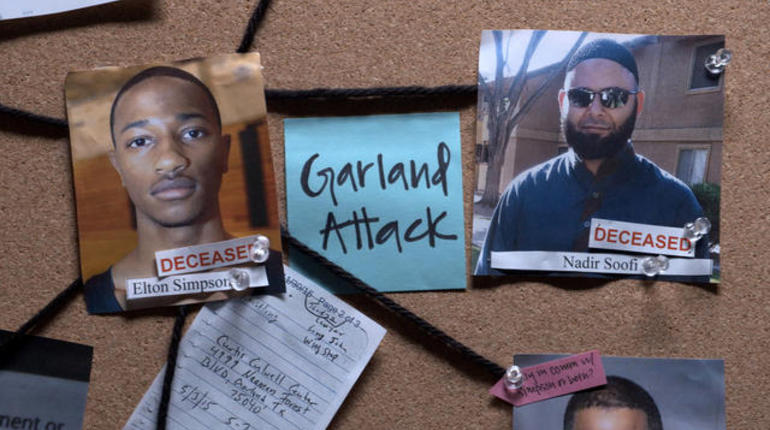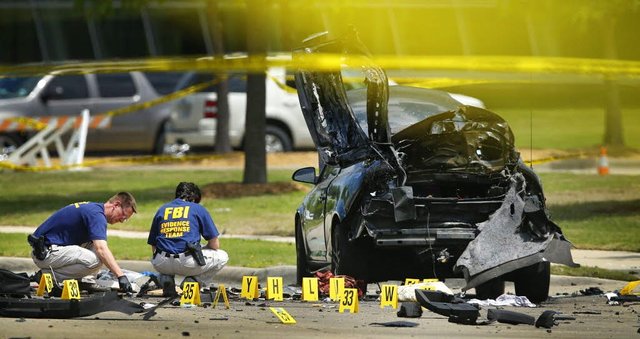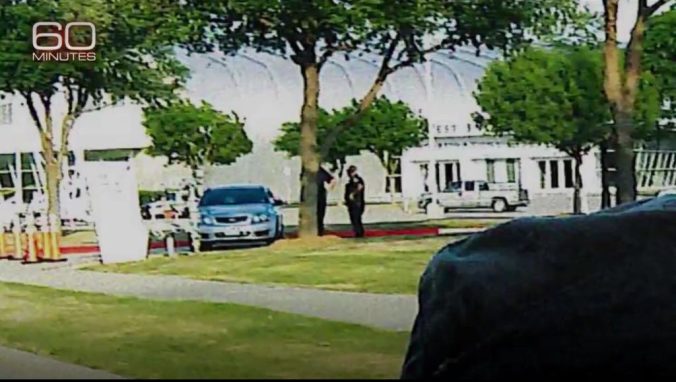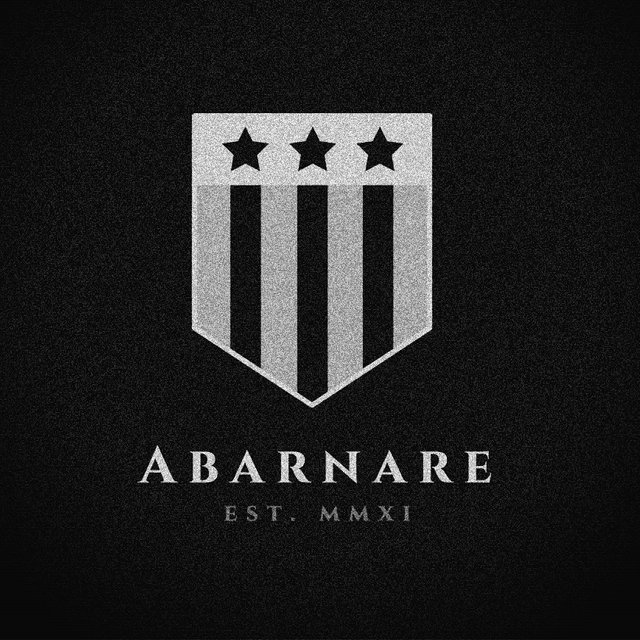FBI Ordered First ISIS Attack In USA

On May 3rd 2015, two armed men, Elton Simpson and Nadir Soofi opened fire outside the Curtis Culwell Center in Garland, Texas, injuring security guard Bruce Joiner. Nearby local police officers returned fire, killing both gunmen before they were able to make their way into the venue. The attack marked the first terrorist attack attributed to the Islamic State in the United States.
The event, hosted by the New York based American Freedom Defense Initiative (AFDA), offered a $10,000 reward for the best cartoon depicting the Islamic prophet Muhammad. The event featured speeches by Pamela Geller, president of AFDI, as well as Gert Wilders, a Dutch lawmaker known for his outspoken criticism of Islam. Wilders was reportedly on a Al Qaeda hit list prior to the Garland event. The event was planned in order to make a stand for free speech in response to outcries and recent terrorist attacks such as the January 2015 attack in France, in which 12 people were killed by gunmen in an attack targeting the office of satirical newspaper Charlie Hebdo, which had lampooned Islam in their own depictions of Muhammad. In February 2015, a similar deadly attack took place in Copenhagen, Denmark targeting an art contest very much like the Garland Texas event.
For those of you who have been paying attention, it should come as no surprise that the FBI had known the primary suspect for nearly ten years prior to the 2015 attack.
The FBI investigation into Simpson began in Phoenix in 2006 because federal investigators believed he was associated with someone the government believed was trying to set up a terrorist cell in Arizona, according to court documents. That person was Hassan Abu Jihaad, a former U.S. Navy sailor who had been arrested in Phoenix and was ultimately convicted of terrorism-related charges.
Agents elicited the help of an informant who befriended Simpson and met with him three to four times per week, according to court records. The informant, Dabla Deng, a Sudanese immigrant, had been working as an FBI informant since 2005 and was instructed to tell Simpson he was a recent convert to the religion. Over the next few years, Deng would tape his conversations with Simpson with a hidden recording device accumulating more than 1,500 hours of conversations.
In a 2007 conversation, Simpson told the informant that "Allah loves an individual who is 'out there fighting (non-Muslims)' and making the difficult sacrifices such as living in caves, sleeping on rocks rather than sleeping in comfortable beds and with his wife, children and nice cars," according to court documents. Simpson also said "If you get shot, or you get killed it's (heaven) straight way."
By 2009, Simpson was more strident in the recorded conversations, telling the informant that he was tired of living under non-Muslims and that his money and taxes are going toward their weapons, according to court documents.
Federal agents interviewed Simpson in early 2010 and those conversations became the basis of the government's case against him. Federal court documents indicate that Simpson was under federal investigation in Phoenix in 2010 after an undercover informant told FBI agents that Simpson planned to go to Africa to study in a madrassa and to fight in a jihad.
In 2011, Simpson was convicted of making a false statement to the government because he denied to an FBI agent that he planned on traveling to Somalia after arriving in South Africa. Despite the hours of recordings, the government prosecuted him on only one minor charge - lying to a federal agent. Years spent investigating Simpson for terrorism ties resulted in three years of probation and $600 in fines and court fees.
"I have to say that I felt like these charges were completely trumped up, that they were just trying to cover up what had been a very long and expensive investigation and they just couldn't leave without some sort of charges," Simpson's attorney, Kristina Sitton, told the Associated Press. Additionally, one federal official familiar with the investigation told the Associated Press that the agency did not have any indication that Simpson was plotting an attack.

Hours before the attack, Simpson's Twitter account created a post demanding readers follow a second account controlled by notorious ISIS fighter Junaid Hussain. And within minutes of the first bullets being fired and while details of the attack were still vague, Hussain posted messages praising the gunmen as Muslim 'brothers' and revealed their target had been a exhibition where artists were drawing pictures of the Prophet Mohammed. The digital connection between Simpson and Hussain raises the chilling prospect that others may well have known about the Texas attack plot in advance.
In June 2015, Abdul Malik Abdul Kareem was charged with helping plan the 2015 Garland attack as well as an additional attack on the NFL Super Bowl.
According to an indictment filed in federal court in Phoenix, In January 2015, Kareem hosted Simpson in his home to discuss plans to travel to Texas to attack the Garland event. Moreover, Abdul Kareem practiced shooting with Simpson, Soofi in the remote desert outside Phoenix between January and May 2015. According to the indictment, Kareem also provided weapons the suspects used in the Garland attack. During a court hearing, prosecutors claimed they obtained their information from a confidential informant.
In March 2016, Abdul Malik Abdul Kareem was found guilty of conspiring to support Islamic terrorists by helping to plan the 2015 Garland attack. In 2017, Kareem was sentenced to serve 30 years in prison.
Was there any indication that the agency was aware of Simpson's desire to attack the event in Garland?
According to reports the FBI continued to maintain an open investigation into Elton Simpson at the time of the shooting due to his social media posting.
According to chairman of the House Homeland Security Committee, Congressional Rep. Michael McCaul, the Department of Homeland Security and the FBI had issued a joint intelligence bulletin to local law enforcement on April 20th warning that the Garland event was a possible target for a terrorist attack. The bulletin said that social media accounts linked to extremists had been focusing on the contest. McCaul said that the bulletin had resulted in increased security around the event.
Those social media accounts were in fact associated with Elton Simpson. FBI director James Comey revealed that the agency learned several hours before the event in Texas that a man under investigation for extremist activities might show up and alerted local authorities. About one week later, Police Chief Mitch Bates claimed they "had no information from the FBI or anyone else that Elton Simpson posed a threat to our event.”
It was revealed that the FBI had an undercover agent present at the event prior to the attack. Simpson had been communicating with Erick Jamal Hendricks, an online recruiter for the Islamic State who became an FBI informant. Hendricks went on to make an online introduction between Simpson and the undercover agent and became the nexus between them. As a result of that introduction, Simpson and the undercover agent corresponded online.
Shockingly, after Simpson posted a link to the “Draw Muhammad” event on social media, the undercover agent wrote: “Tear Up Texas.” In response, Simpson said, “Bro, u don’t have to say that ... U know what happened in Paris ... I think ... Yes or no?” he wrote, referring to the January 7, 2015, attack on Charlie Hebdo. “Right,” the agent responded. “So that goes without saying,” Simpson responded. The FBI was, perhaps literally, the inspiration for the terrorist plot.
Moreover, it was revealed that the FBI agent sent two photos from the convention center parking lot moments before the shooting to Hendricks. One shows a police officer and another person standing in the distance near a tree. Did Hendricks share these photos with Simpson and Soofi? Did the FBI literally scout out the venue for the attack perpetrators?

According to reports, the undercover FBI agent had been sitting in a vehicle outside the Garland convention center just as events wrapped up at the cartoon contes when the attacker's sedan made an abrupt stop in the road. As the agent drove around the car, two men with an Islamic State flag, wearing body armor and carrying military-style rifles, got out and opened fire on the venue. The agent drove away and was later stopped by police. The agent’s presence at the contest wasn’t publicly revealed until 15 months after the attack and has raised questions about whether authorities could have done more to stop the attack.
“We are convinced that there is much more to this story than the FBI has admitted ,” said Trenton Roberts, an attorney for security guard Bruce Joiner, who was injured in the attack.
Following the revelations, chairman of the Homeland Security and Government Affairs Committee, Senator Ron Johnson, launched an investigation into whether the FBI knew about the 2015 Garland attack plot and did nothing to stop it as well as misleading Congress about the circumstances of the attack.
“It is concerning that when I wrote to the FBI and Department of Justice, they never told me about the fact that they had some FBI asset, whether it was an agent or informant, tailing Soofi and Simpson... Why didn’t they intervene? As a member of the Senate oversight committee, I think these agencies should be honest when we actually ask them the questions. But it begs the question, what was the FBI doing in Garland, and why wasn’t the agency direct with me when we first started writing letters about this back in 2015? All I know is we don’t have the straight story from the FBI,” Johnson said. “We are just so fortunate that local law enforcement was able to take care of the situation to prevent another mass attack. This was a real tragedy averted,” Johnson added.
In 2017, the victim of the attack, security guard Bruce Joiner, filed a lawsuit against the FBI for its role in the attack and accused the agency of an ongoing cover-up.
Interestingly, it was later revealed that the attack suspect Nadir Soofi had purchased the gun he used in the attack from Lone Wolf Trading Co. in Phoenix, Arizona, in 2009. Lone Wolf, it has turned out, was part of Operation Fast and Furious, a secret effort to sell illegal weapons to criminals and track them back to drug cartels. However, federal agents ended up losing track of many of the guns some of which were found to have been linked to the murder a of U.S. Border Patrol in Arizona in 2010.
...
...
Stay tuned for more @eranraba
Twitter: @Abarnare
